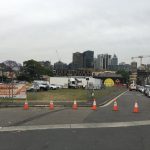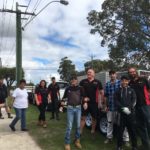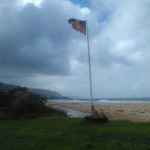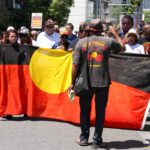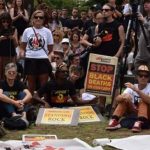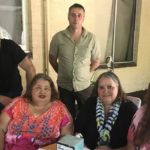Ensuring Aboriginal Affordable Housing in Redfern-Waterloo: An Interview With Warren Roberts
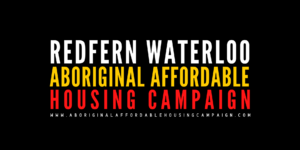
As Professor Gary Foley recalls in his history of the Black Power movement in Redfern, the inner city suburb is of particular significance to First Nations people in Warrang-Sydney. It was the centre for the rising Aboriginal rights movement back in the late 60s and early 70s.
Established in 1970, the Redfern Aboriginal Legal Service saw the introduction “of the notion of free shop-front legal aid” into the “Australian social and political context”, according to the Gumbaynggirr elder. And the Aboriginal Medical Service Redfern opened the following year.
However, the then estimated population of over 30,000 First Nations people has declined over recent decades, and at the same time, Redfern and neighbouring Waterloo have been undergoing a gentrification project, which has been picking up of late.
Of major significance was the redevelopment of The Block, which was the first land owned freehold by any Aboriginal community since British takeover. And despite a promised allocation of affordable housing for local First Nations people in that development, no funding was ever forthcoming.
Maintaining connection
As Redfern has a connection to the First Nations civil rights movement dating back to the 1938 Day of Mourning and the 1965 Freedom Ride, an alliance of Aboriginal community-controlled organisations and allies has established a campaign calling on the NSW government to preserve this.
Launched on 21 September, the Redfern-Waterloo Aboriginal Affordable Housing Campaign is calling on the state to ensure that 10 percent of government redevelopments in the area be allocated to Aboriginal affordable housing, as well as guarantees around social housing and employment.
The organisers point out that the NSW government has already committed to the SEPP 70 policy, which promotes the development and maintenance of social housing in local government areas where it is needed. And the campaign aims could easily be built upon this.
The alliance has already gained the support of both state and federal MPs. This entails NSW Greens MP Jenny Leong, NSW shadow Aboriginal affairs minister David Harris, Australian Labor MP Tanya Plibersek and Australian Greens Senator Mehreen Faruqi.
Forging change
The campaign is being led by Thunghutti and Bundjalung man Warren Roberts, who’s also the founder of YARN Australia: a social enterprise designed to build connection and unity between Aboriginal and Torres Strait Islander peoples and the non-Indigenous population.
Sydney Criminal Lawyers spoke to Warren Roberts about why it’s important to maintain the First Nations community in Redfern-Waterloo, the significance the region has for it, and how the campaign will be moving forward.
Firstly, the Redfern-Waterloo Aboriginal Affordable Housing Campaign is calling for a guaranteed 10 percent affordable housing allocation for First Nations people in government redevelopments in the area.
Redfern and Waterloo hold particular significance for Aboriginal people. Mr Roberts, can you speak about why that is? And why it’s important to maintain?
Redfern is at the heart of Aboriginal and Torres Strait Islander people. It is significant because of the civil rights movement for Aboriginal people in this country, the setting up of all the Aboriginal services in the area, and because of the call for self-determination.
At the height of the Aboriginal population moving to the cities in the 70s, there was over 30,000 in Redfern.
So, we have generations and generations of Aboriginal and Torres Strait Islander people, who have lived in Redfern or Waterloo. And they have a strong connection with the place.
Over the years, many of our people have been displaced, for whatever reason. Redfern will always be a place, where our people call home.
And we have generations who have been moved out of the area, and if they had an opportunity of affordable housing they would return.
It’s important for our community, our young people, our mental health and our connection to local, culturally appropriate services.
Those services were set up in the act of self-determination – to have Aboriginal and Torres Strait Islander organisations as community-controlled and self-determining.
What sort of redevelopment is happening in the Redfern-Waterloo area?
There are a number of different sites. There’s one on Elizabeth Street in Redfern at the PCYC site.
There’s a development at Waterloo Metro. There’s going to be hundreds and hundreds of units. I believe around 700 in that one little site.
Then you’ve got the redevelopment that’s happening in the Waterloo Precinct, which is being split into three different precincts: Waterloo South, Waterloo Centre and North.
So, would you say the area has been undergoing gentrification for some years – which has already been problematic for the First Nations community – and now that’s expanding?
Yes. And what we’re saying is all the land that’s being redeveloped is public land. It should include a First Nations voice in it, with a commitment of 10 percent.
What we’re asking is pretty reasonable, considering the state government is already committing to the policy of SEPP 70.
The campaign also has social housing and employment components. What do they involve?
When you have housing, there’s local services to support the people who live in those communities. So, it’s not just about a house, it’s also about social and emotional wellbeing, and a whole lot of service needs.
Instead of funding new organisations, we’re saying fund the existing organisations that are already in the area to continue the work that they’ve been doing to cover these social needs.
That’s why we’re aiming the campaign at Gladys Berejiklian, Melinda Pavey, Rob Stokes and Gareth Ward, because it encapsulates a whole lot of things.
The campaign is being led by an alliance of Aboriginal community-controlled organisations and allies. Can you talk a bit on who’s involved, as well as the support the campaign has already garnered?
We have the support of local and historical Aboriginal-controlled organisations that were set up in the 70s, as well as allied services in the area: youth services, legal services and housing services that cater for our communities.
What’s unique about it? It’s an alliance around ensuring that there’s a commitment for Aboriginal affordable housing, that there’s a commitment for the return of 16 percent of Aboriginal people that can’t live there, as well as increased social housing.
It’s historical in the sense that it’s where the civil rights movement began. And it’s inspiring for the younger generation growing up in Redfern to see the community coming together to support a cause such as this.
And lastly, Mr Roberts, what’s the next step from here? How does the alliance plan to bring about these aims to ensure the right to housing is maintained?
We have an online petition. It is almost 10,000 signatures now. And we’ll continue gaining further support from our allies.
We have allies both nationally and in the state of NSW.


